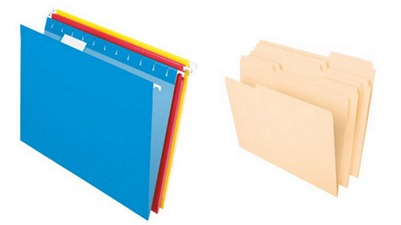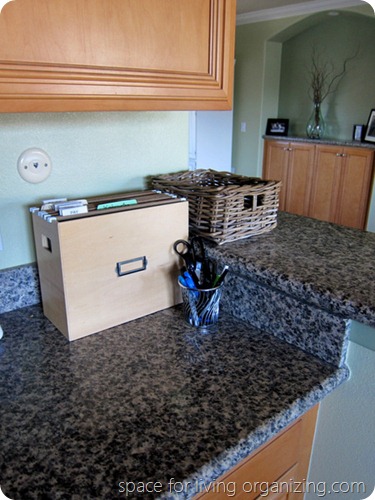We’ve been elbows deep in filing with our Organize your Paper Link Party. (If you haven’t linked up, it is not too late! Link up to last week’s party and see our schedule for the next coming weeks to follow along).
I know what some of you might being saying, “I hate filing!” You may even assign labels to yourself like “piler” or “disorganized.” But I believe many times filing is made way too complicated. I’ve come to live by tips that keep filing simple and manageable.
Although you can spend hours creating a fabulous filing system, the most important thing is that it can be maintained for the long haul without a lot of time! Filing should be just as easy as making piles! Filing is a vertical pile if you will. Following these simple rules can help make filing less of a chore and closer in nature to making piles.
So here are the rules I use to keep filing simple and easy to do instead of a chore to dread.
1. Keep Files Easy to Access
If your files are hidden in the back bedroom or basement you just won’t use them. Files have to be close to where you process paperwork.
I have experienced this in my own home. I keep a file box on my kitchen counter by the phone for my everyday actionable papers. Financial and reference files are in my desk where I process the more involved paperwork.
In order to be useful, files have to remain a trusted source to store papers (David Allen, Getting Things Done). In other words, if files are too hard to access or you stop looking at them altogether, papers are left out because you don’t trust yourself to look in your files for paper.
This doesn’t only happen with files. Stacking paper trays can fall prey to the same situation. Your piles around your home can also become untrusted. You start making a new current pile and ignore past piles. Once you acknowledge no system will work unless you use it, our next tip becomes one of the most important.
2. Schedule Time to File
This is not as daunting as it sounds. I only file every other month. And sometimes I do it even less then that!
Did you catch the contradiction to the first rule of keeping files accessible? Honestly, I hardly think of my kitchen file box as filing. I even demonstrated how fast processing paperwork can go in a video.
Seriously, they are my vertical piles, easy to get in and out of without unsightly paper everywhere. I have weekly/bi-monthly time (depending on the file) to go through my action files. Files (or if you prefer stacking paper trays) become a trusted place to store your paper when you use them on a consistent basis. Part of that includes setting aside time to get your action tasks done.
Also I write everything I need to do in my planner. This avoids using paper as visual reminders. I know some are afraid if they’ll file it, they’ll forget it. While this is definitely a valid argument when it comes to leaving your gym bag or briefcase by the door for a morning reminder, if you act this way with all paper it can turn into a real problem! Things will be lost as you shuffle piles around to find your current to-do or you may forget the task altogether.
Paperwork needs a system. Whether it is a file box on the kitchen counter or wall files or stacking trays, a system that makes it easy to sort and conquer those daily to do’s is all a way of filing.
3. Make Broad Categories
The more you divide subjects into smaller and smaller groups, the more complicated your filing systems becomes and the less likely you are to maintain it. More categories create more files to look in. With many narrow categories, filing becomes murky. “Do I file this under things to-do’s or under travel/west cost or travel /kids?”
To avoid this, keep your categories as broad as possible. (Especially keep this tip in mind if you dread filing. If you are giddy at the idea of filing on a Friday night then by all means, create as many files as you’d like).
Think of it as creating a container for, let’s say batteries. You can have one container labeled batteries and throw in every type, mingling them together. Or you can have multiple containers labeled with each type, AA, AAA, C and D batteries. You can decide what is organized enough for you. To me the simpler the better.
4. Don’t Try to File Everything
Think before you file! What is the likelihood you will refer to this paper again? Can you find the information elsewhere, like on-line? Are you really going to use this? How long do you want to hang on to it before you try this latest tip or recipe?
Question everything you keep and file.
5. Keep all tabs on one side
I first heard this tip in the book, Taming the Paper Tiger. Once I tried it, I’ve never looked back! Instead of alternating or staggering tabs, I keep all the tabs on the same side (either the right or left).
There are lots of reason why it works better then staggering.
- It is easier on the eyes, since you don’t have to continuously scan and search for the file tab.
- You don’t have to worry about putting each file back in the exact right spot to keep the pattern going.
- When you have to add a file later down the line, you won’t have to spend 10 minutes moving the tabs around until everything lines up.
Try it and you’ll become a believer too!
6. No color coding
What!I know this may sound like down right blasphemy to some, but color coding is more trouble then it is worth. Remember we are keeping things simple!
It always happens that when you go to add a new file, lo and behold, you don’t have the right color. You only have yellow and blue and you need a green. Now your papers sit out waiting for you to get more of the right color files. Or you buy plenty of each color but now you have to find a place to store all these extra colored files you may or may not need.
Keep filing easy for yourself. Make your files last for years and years by not committing yourself to one color for one type of file.
7. Use a Hanging file for Everything!
Okay, almost everything. I am not super strict on this last rule but everyone gets so caught up on when to use manila folders and when to use hanging files. Just use hanging at all times.  I think they are so much easier to use. One file for one subject. You don’t have to worry about breaking things down into subsets. The files are easy to take in and out.
I think they are so much easier to use. One file for one subject. You don’t have to worry about breaking things down into subsets. The files are easy to take in and out.
Once you begin to follow these simple filing suggestions, you will find yourself converted to the ease of a simple file system and hopefully find less piles around the house.
What about your filing musts? Any tips that make it less of a chore for you?


I love these filing tips! I especially need help with #3, but all these ideas are truly helpful. I love your blog, Autumn. 🙂 Also, my jaw dropped to see my face on your home page sidebar!!! Haha–what a surprise!
Thanks Stacy! I always smile when I see your face saying hello from your wintry landscape.